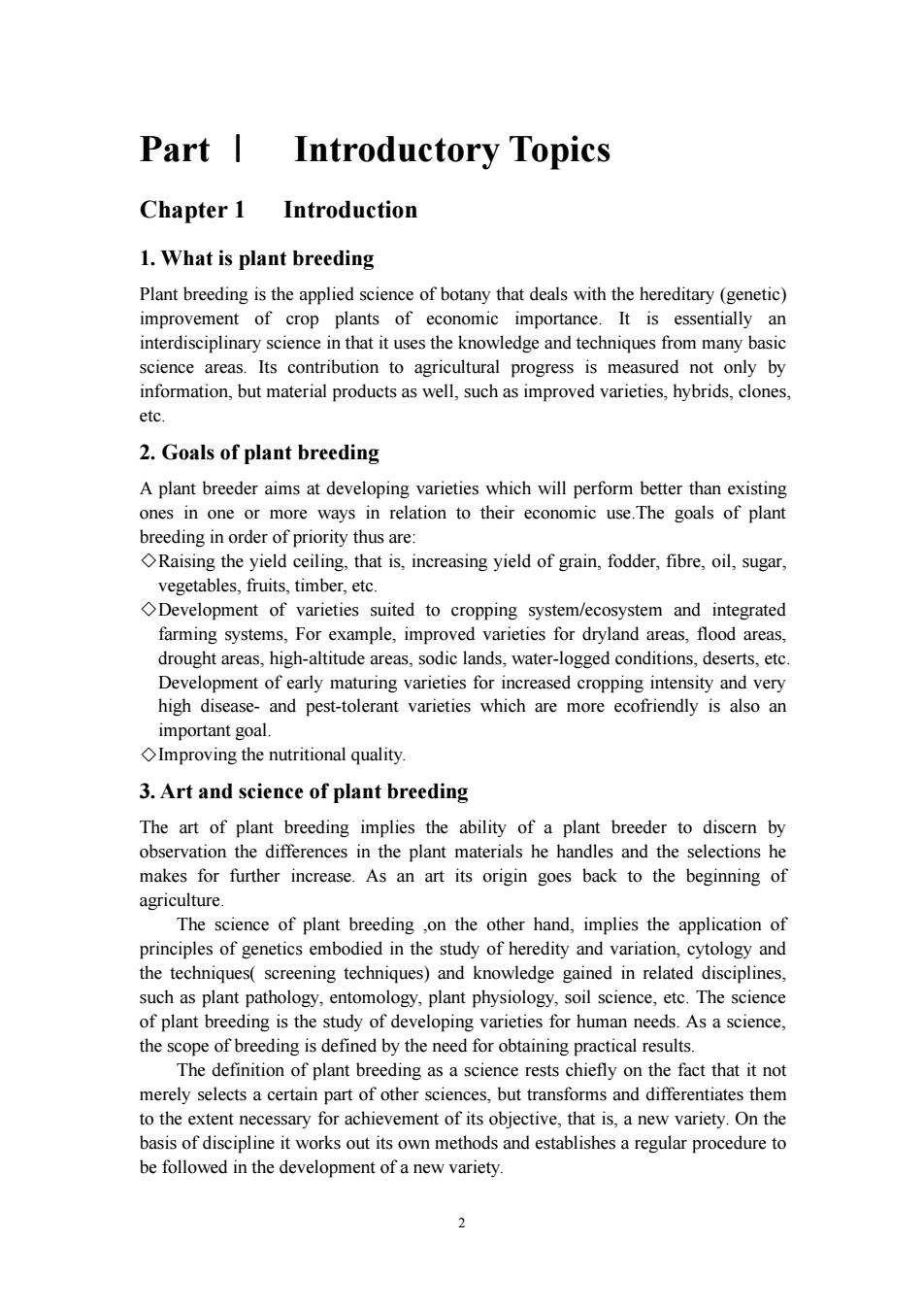正在加载图片...

Part Introductory Topics Chapter 1 Introduction 1.What is plant breeding Plant breeding is the applied science of botany that deals with the hereditary(genetic) improvement of crop plants of economic importance.It is essentially an interdisciplinary science in that it uses the knowledge and techniques from many basic science areas.Its contribution to agricultural progress is measured not only by information,but material products as well,such as improved varieties,hybrids,clones, etc. 2.Goals of plant breeding A plant breeder aims at developing varieties which will perform better than existing ones in one or more ways in relation to their economic use.The goals of plant breeding in order of priority thus are: Raising the yield ceiling,that is,increasing yield of grain,fodder,fibre,oil,sugar, vegetables,fruits,timber,etc. Development of varieties suited to cropping system/ecosystem and integrated farming systems,For example,improved varieties for dryland areas,flood areas, drought areas,high-altitude areas,sodic lands,water-logged conditions,deserts,etc Development of early maturing varieties for increased cropping intensity and very high disease-and pest-tolerant varieties which are more ecofriendly is also an important goal. Improving the nutritional quality. 3.Art and science of plant breeding The art of plant breeding implies the ability of a plant breeder to discern by observation the differences in the plant materials he handles and the selections he makes for further increase.As an art its origin goes back to the beginning of agriculture. The science of plant breeding,on the other hand,implies the application of principles of genetics embodied in the study of heredity and variation,cytology and the techniques(screening techniques)and knowledge gained in related disciplines, such as plant pathology,entomology,plant physiology,soil science,etc.The science of plant breeding is the study of developing varieties for human needs.As a science, the scope of breeding is defined by the need for obtaining practical results. The definition of plant breeding as a science rests chiefly on the fact that it not merely selects a certain part of other sciences,but transforms and differentiates them to the extent necessary for achievement of its objective,that is,a new variety.On the basis of discipline it works out its own methods and establishes a regular procedure to be followed in the development of a new variety. 22 Part Ⅰ Introductory Topics Chapter 1 Introduction 1. What is plant breeding Plant breeding is the applied science of botany that deals with the hereditary (genetic) improvement of crop plants of economic importance. It is essentially an interdisciplinary science in that it uses the knowledge and techniques from many basic science areas. Its contribution to agricultural progress is measured not only by information, but material products as well, such as improved varieties, hybrids, clones, etc. 2. Goals of plant breeding A plant breeder aims at developing varieties which will perform better than existing ones in one or more ways in relation to their economic use.The goals of plant breeding in order of priority thus are: ◇Raising the yield ceiling, that is, increasing yield of grain, fodder, fibre, oil, sugar, vegetables, fruits, timber, etc. ◇Development of varieties suited to cropping system/ecosystem and integrated farming systems, For example, improved varieties for dryland areas, flood areas, drought areas, high-altitude areas, sodic lands, water-logged conditions, deserts, etc. Development of early maturing varieties for increased cropping intensity and very high disease- and pest-tolerant varieties which are more ecofriendly is also an important goal. ◇Improving the nutritional quality. 3. Art and science of plant breeding The art of plant breeding implies the ability of a plant breeder to discern by observation the differences in the plant materials he handles and the selections he makes for further increase. As an art its origin goes back to the beginning of agriculture. The science of plant breeding ,on the other hand, implies the application of principles of genetics embodied in the study of heredity and variation, cytology and the techniques( screening techniques) and knowledge gained in related disciplines, such as plant pathology, entomology, plant physiology, soil science, etc. The science of plant breeding is the study of developing varieties for human needs. As a science, the scope of breeding is defined by the need for obtaining practical results. The definition of plant breeding as a science rests chiefly on the fact that it not merely selects a certain part of other sciences, but transforms and differentiates them to the extent necessary for achievement of its objective, that is, a new variety. On the basis of discipline it works out its own methods and establishes a regular procedure to be followed in the development of a new variety